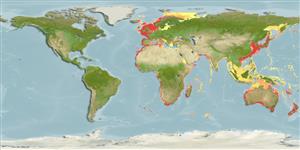Classification / Names
Common names from other countries
Référence principale
Taille / Poids / Âge
Max length : 90.0 cm TL mâle / non sexé; (Ref. 6953); common length : 40.0 cm TL mâle / non sexé; (Ref. 6953); poids max. publié: 8.0 kg (Ref. 35388); âge max. reporté: 12 années (Ref. 5377)
Length at first maturity
Lm 36.2, range 29 - 35 cm
Environnement
; marin; saumâtre benthopélagique; océanodrome (Ref. 35388); profondeur 5 - 400 m (Ref. 9563), usually 50 - 150 m (Ref. 4968)
Climat / Gamme
Temperate, preferred 23°C (Ref. 107945); 75°N - 49°S, 17°W - 177°E (Ref. 54935)
Distribution
Worldwide in distribution. Eastern Atlantic: Norway to South Africa, also the Mediterranean and Black Sea. Western Pacific: Japan, Korea, Australia and New Zealand. Also known from the Indian Ocean.
Pays | Zones FAO | Écosystèmes | Occurrences | Introductions
Description synthétique
Épines dorsales (Total): 9 - 11; Rayons mous dorsaux (Total): 22-24; Épines anales 4; Rayons mous anaux: 20 - 23. Gill rakers rudimentary. Minute scales present. Highly compressed body (Ref. 4253). Large dark spot, surrounded by a light ring on each side of the body (Ref. 35388).
Statut dans la liste rouge de l'IUCN (Ref. 115185)
Menace pour l'homme
Harmless
Utilisations par l'homme
Pêcheries: commercial; pêche sportive: oui; Aquarium: Aquariums publics
Outils
Articles particuliers
Télécharger en XML
Sources Internet
Estimates of some properties based on models
Phylogenetic diversity index
PD50 = 0.7656 many relatives (e.g. carps) 0.5 - 2.0 few relatives (e.g. lungfishes)
Niveau trophique
4.5 ±0.8 se; Based on diet studies.
Résilience
Faible, temps minimum de doublement de population : 4,5 à 14 années (K=0.15; tm=3-4; tmax=12)
Vulnérabilité
High to very high vulnerability (68 of 100)
Catégorie de prix
